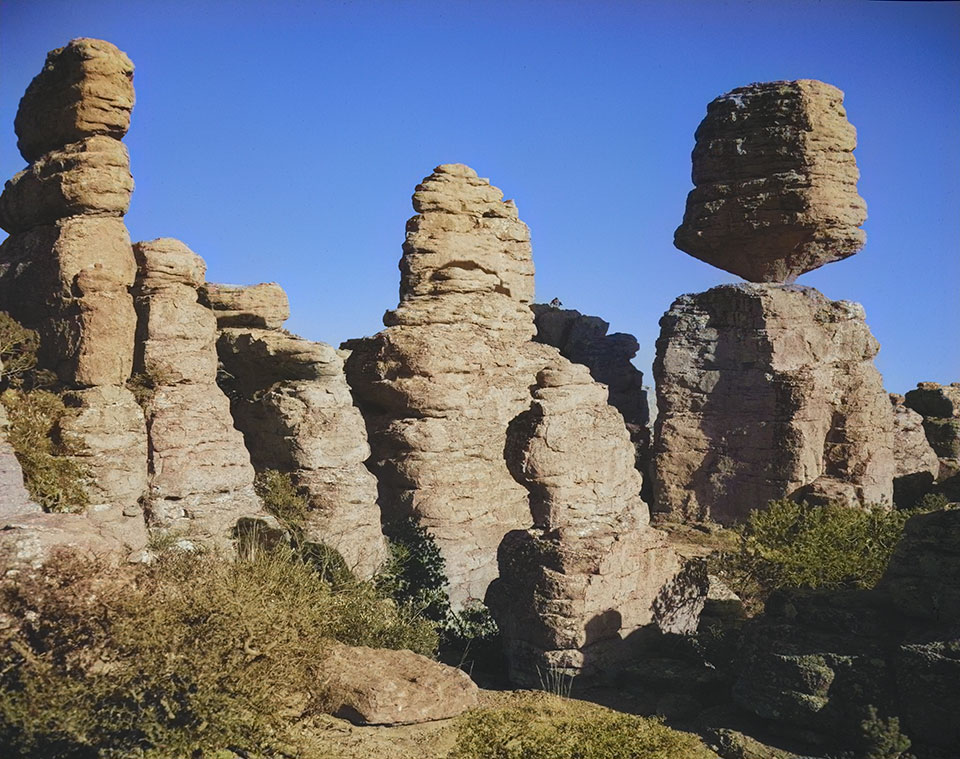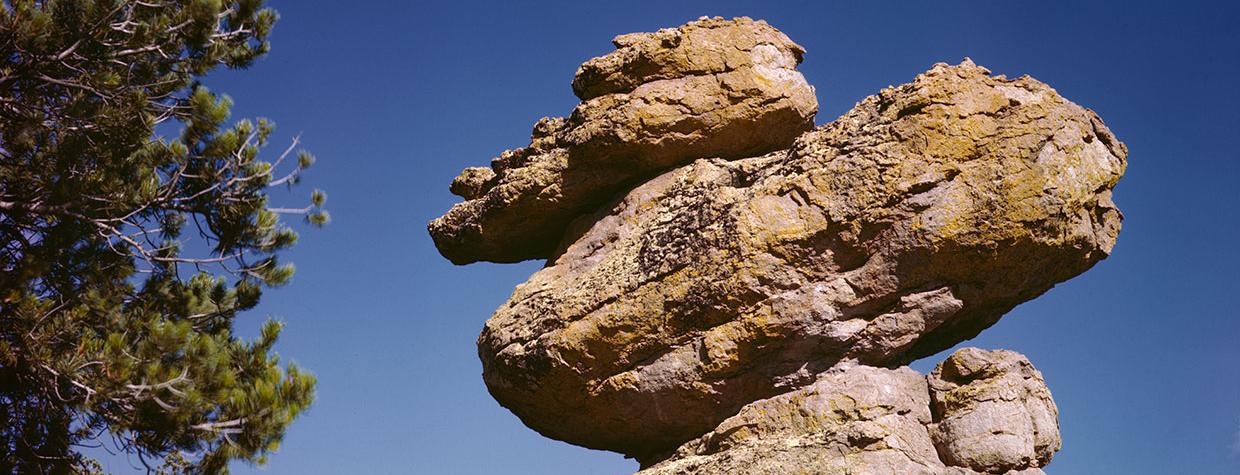Tucked away in the southeastern corner of Arizona is the Chiricahua National Monument. It covers 10,693 acres in the extreme northern end of the Chiricahua Mountains. Aside from the beauties to be expected in a cool region that rises thousands of feet above the floor of the surrounding desert lands, it is a fount of comedy, an unfailing source of natural humor unexcelled perhaps anywhere on Earth. In a forest setting that has as large a variety of plants as any place of equal size in the United States are thousands of rock figures, carved by the forces of erosion into comical shapes, parodying well-known characters of fact and fiction. These cartoons in stone have an interesting history that is as old as that of the Grand Canyon, and they draw people back again and again to enjoy the fanciful faces and shapes that peek out from the verdant growth as though set in a garden to delight the child that lives in each of us.
The visitor opens the book that is Chiricahua 33 miles east of Willcox and 62 miles from Douglas, Arizona. East of this mountain paradise is the flat San Simon Valley, and to the west, the Sulphur Springs Valley. These lower lands make the mountains seem higher, and the cool greenness of the forest is doubly welcome after passing through the lowlands. An excellent road winds up Bonita Canyon through the monument and ends on Massai Point. But the major portion of the preserve must be seen afoot or on horseback. About 14 miles of delightful trails turn and twist through canyons and back to the headquarters area near the entrance, each one a chapter in itself, and every rock monument a commentary on some ancient tale, the pages embellished with the finest of nature’s living handiwork.
The road climbs from 5,320 feet above sea level through the forest where, at 6,871 feet elevation, there is a sweeping panorama of erosion-chiseled rock, and tiers of great trees framing distant views of other high places. In one direction, the spectacular Cochise Head rests eternally upon a craggy mountain peak, being itself the summit. Cochise was an Apache warrior, having many Indians at his call. As early as 1695, the Spaniards are known to have followed them into the hills, where we can be sure they scattered like the wild turkeys from which the mountains take their Apache name. Bits of Spanish horse gear and coins are sometimes found as a relic of those days.

Before that, a Pueblo people lived in the foothills, and remnants of their pottery and of their houses have been located. The Indians made their final stand in the neighborhood against the United States Army. Cochise was never captured, but Geronimo was shipped from Fort Bowie, close by, as an exile in Florida. Now, Cochise Head, with a 100-foot tree for an eyelash, sleeps peacefully and has a place as part of the serenity of the land.
All trails lead down from Massai Point. Snow covers the area in winter, and the small trees, dwarfed by the elements, make a natural garden here, showing vistas in every direction. A wayside lookout point of rocks has seats from which the interesting Totem Pole can be enjoyed. It stands about 30 feet above the other stones, slim and precariously thin.
Rhyolite Canyon leading into Hunt Canyon is one of the trailways, and its walls are manned by “rock soldiers” interspersed with trees that grow wherever they can get a foothold. Ferns and wildflowers spring up everywhere, and the voice of the canyon wren, warbling his scale, provides sound effects. A vividly colored Mushroom Rock has “grown” on the hillside, taking its shades from fungus that clings to it. Beyond is Donald Duck. This Disney figure, one feels sure, is the original — baleful glance, cocked hat and all. His perch is so high that the photographer must scramble up a canyon wall, never sure when Donald may decide to nip him for his temerity.
From a forested ridge that the trail reaches, the Heart of Rocks section can be glimpsed before its treasures are explored at first hand. It looks like a workshop with some unfinished stones in progress, and a multitude of uncut slabs, beside the remarkably lifelike figures that await shipment. The variety of subjects is only surpassed by the differences in size and treatment. There are the Baked Potato, the Kissing Rocks, Thor’s Hammer, Anvil, Old Maid and dozens more. The Big Balanced Rock needs a word for itself: It is a massive block weighing 652 tons, measuring 25 feet by 20, balanced on a point that is only 4 feet, 3 inches! In spite of the appearance it gives of being ready for the next wind to send it hurtling, we are told that it is only two-thirds eroded and the jutting rock above the narrow throat will protect it for a long time to come.

The Pinnacle Balanced Rock is not as large and gives quite a different effect. Although massive, its greater height in proportion makes it seem more delicate, and the trees that frame it soften the rock contours to make it always a delightful subject for a picture.
Funny as the Old Maid is with her tilted nose and mass of hair, or the silly lovers of the Kissing Rocks that caricature all love that is too demonstrative in public, the funniest things in the whole monument are Punch and Judy. Nature has arranged the perfect setting, with partially drawn curtains of stone and seen against the sky, with nothing to distract the attention.
Each trail has its catalog of characters, and many along the way are still waiting to be named. All the while, the forces of erosion go quietly along, remodeling very slowly the figures that we see and working on others that will delight our children in another day.
In between chuckles over the rock formations, the visitor will want to know the geological history of the place. The gneiss and granite that underlie the volcanic rock of which the comics in stone are made show that this area is related to the deeper reaches of the Grand Canyon. Above them were piled layer after layer of lava, coming from vents in the earth in flows, rather than from volcanoes. The gas in the mixture, plus the rapid cooling, led to cracking in various directions and planes and made possible the erratic effects of later erosion. Dacite and rhyolite rock are found in the lava mixture, and some of it fused with an ancient lakebed. The line of fusion with its gypsum is seen at one point along the Bonita Road.
Into this strange land, which was probably denuded of all animal and plant life for many centuries, have found their way a collection of biological specimens that prove a delight to students and provide for the more casual tourist a haven of beauty. From Mexico have come such common plants as the Mexican black oak, Mexican cotton, wild potato and a rarer lily, as well as the red Bouvardia. From the Ozarks came the red columbine, and the butterfly pea is a thousand miles west of its usual haunts. There is an Alaskan orchid if one knows where to look. One of the park botanists had collected 500 different species of plants in the several summers that he was at the monument. The alligator-barked juniper tree, common in the Southwest, here grows to quite unusual proportions.

Animals have followed the plants from outlying regions. It is the only place in the United States where the thick-billed parrot is ever seen. The ruby-throated hummingbird, not ordinarily found west of the Mississippi, breeds here. The tigre from Mexico, the ocelot and even the jaguar have been seen in the forests, as well as the Arizona white-tailed deer that wanders in to feed on its lush vegetation.
Plants and animals thus prove by their presence the unique charms of the Chiricahuas, as if to add to its charming pages. But no inducement is needed for most people, since once seen, this land of the stone comics speaks for itself and calls back to its shady dells its many visitors.

